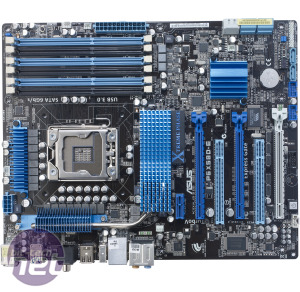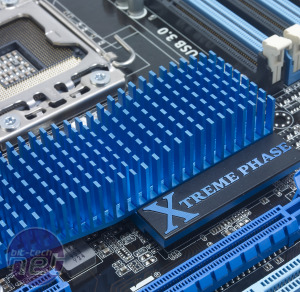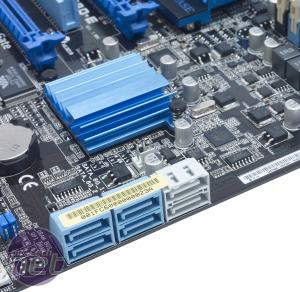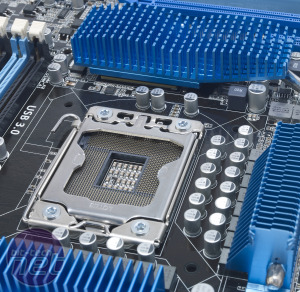
Performance Analysis
We booted up our test suite to see if the D-E could give the excellent UD3R (rev 2) a run for its money. With very little between the two in terms of features and price, performance was going to be the only way we could separate the two boards. It’s important to note that before testing we updated our test board to the latest 0303 BIOS which is publically available on Asus’ website.The various storage control chips on the Asus motherboard worked well, if not brilliantly, achieving data transfer speeds of 204MB/sec write and 248MB/sec read over the SATA 3Gbps ports, and of 206MB/sec write and 305MB/sec read over the SATA 6Gpbs ports. These results compare favourably to those obtained from the UD3R (rev 2), with the D-E achieving faster read speeds over both busses. However, the D-E was also slightly slower than the UD3R (rev 2) on write speeds, so the two boards are tied on the storage performance front.
The D-E failed to outperform the UD3R (rev 2) in our Media Benchmarks though, and its stock speed overall score of 2,073 was one of the poorer results we’ve seen. Having said this, the UD3R (rev 2), which recorded the highest stock result we’ve seen, was only 33 points quicker - a tiny margin, and one which wouldn’t make any discernable difference when in use.
In Crysis the D-E ran the game at the same 31fps minimum, but was 2fps faster when it came to the average frame rate. This indicates that the D-E can bus game data around a tiny bit quicker than the UD3R (rev 2), but not to a huge degree.
Overclocking
Eager to use those power phases and play with the BIOS, we tested the D-E for its maximum QPI. The BIOS is logically arranged and easy to use, with all the overclocking options gathered in the Extreme Tweaker menu. We’d go as far as saying that the D-E has the edge over the UD3R (rev 2) in the BIOS friendliness stakes, but that’s not to say the UD3R (rev 2) is in any way awkward to use – the Asus BIOS is just a little easier to navigate.We managed to push the D-E to a 220MHz QPI, with an ICH voltage of 1.2V and a QPI/DRAM voltage of 1.37V. This is the same great result as achieved by the UD3R (rev 2), and shows that the D-E is capable of getting the best out of the X58 chipset.
We dropped the QPI back to 200MHz and used a 22x CPU multiplier to overclock our Core i7-980X Extreme Edition from 3.33GHz to 4.4GHz, which required a CPU voltage of 1.38125V and a CPU PLL of 1.96V. At this frequency, the board tore through our tests to achieve an overall score of 2,589 - 39 points more than the 2550 the UD3R (rev 2) managed when it was overclocked to the same level. A particular highlight for the D-E was the 1,895 score in our image editing test which was only four points away from being the fastest score we’ve ever seen from an X58 motherboard.
Crysis saw less improvement from the overclock, with the minimum frame rate jumping from 31fps to 39fps. This left the D-E trailing the UD3R (rev 2) by around 3fps; the Gigabyte produced more gaming performance than the D-E when both were overclocked.
Conclusion
The Gigabyte GA-X58A-UD3R (rev 2) and Asus P5X58D-E are very similar to each other in terms of price, features and performance. The D-E has a few things going in its favour though, such as its extra on-board overclocking features, friendly BIOS, extra power phases and slightly superior performance in our Media Benchmarks when overclocked. Against it however, is its lack of an IDE port, two fewer SATA ports and slightly inferior gaming performance when overclocked.However, the margins we’re talking about here are so small that you’d be hard pushed to notice the difference in a real-world situation. As a result we’d suggest making your decision based on which features are most important to you. If you need lots of SATA ports or an IDE port, the Gigabyte UD3R will do you proud. If you plan to run your PC overclocked for extended periods of time then the Asus D-E’s extra power phases and slightly better overclocked performance should be what you’re looking for.
It’s clear that both boards would make a great basis for a powerful but affordable LGA1366 rig, and with manufacturers and retailers slashing their prices to get your business, there has never been a better time to upgrade either.
- Performance
- x
- x
- x
- x
- x
- x
- x
- x
- x
- -
- 9/10
- Features
- x
- x
- x
- x
- x
- x
- x
- x
- -
- -
- 8/10
- Value
- x
- x
- x
- x
- x
- x
- x
- x
- x
- -
- 9/10
- Overall
- x
- x
- x
- x
- x
- x
- x
- x
- x
- -
- 9/10

Asus P6X58D-E

MSI MPG Velox 100R Chassis Review
October 14 2021 | 15:04












Want to comment? Please log in.